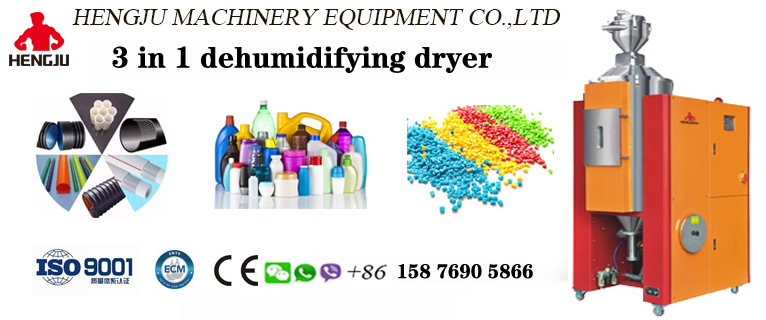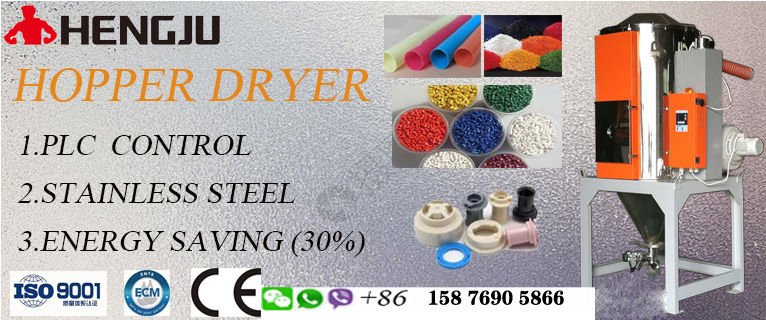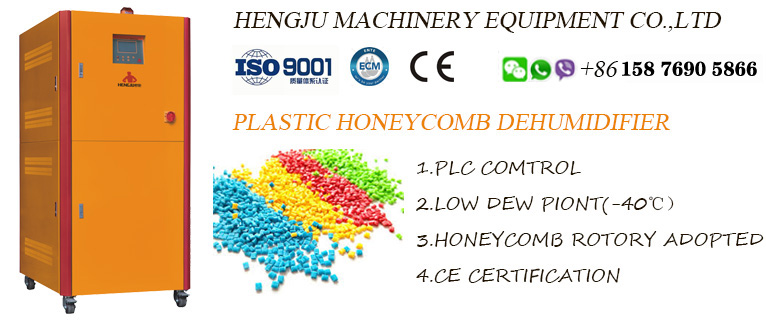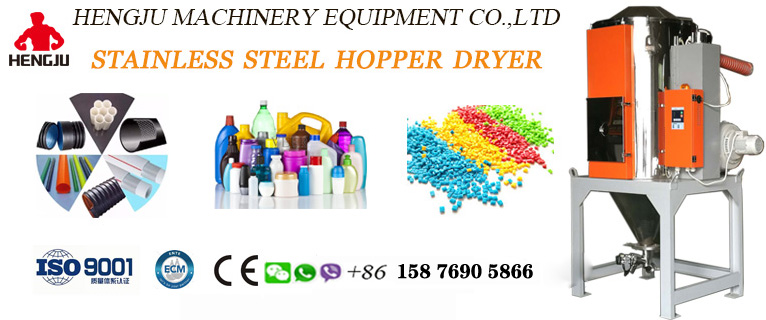The drying of plastic is inevitable for every plastic processor. At the same time, in order to produce high-quality products, this process is also very important. Choosing a reasonable drying technology can help save costs and reduce energy consumption, and the correct evaluation of drying technology and cost is of great significance for choosing a suitable drying technology.
The increase in water content will gradually reduce the shear viscosity of the material. During the processing, due to changes in melt flow properties, the quality of the product and a series of processing parameters will also change accordingly. For example, if the dwell time is too long, the residual moisture content will be too low and the viscosity will increase, which will lead to insufficient filling of the mold and also cause yellowing of the material. In addition, changes in certain properties cannot be directly observed with the naked eye, but can only be discovered through related tests on the material, such as changes in mechanical properties and dielectric strength.

When choosing a drying process, it is of vital importance to identify the drying properties of the material. Materials can be divided into two types: hygroscopic and non-hygroscopic. Hygroscopic materials can absorb moisture from the surrounding environment, while non-hygroscopic materials cannot absorb moisture from the environment. For non-hygroscopic materials, the moisture existing in any environment remains on the surface, becoming "surface moisture" and easy to be removed. However, rubber particles made of non-hygroscopic materials {TodayHot} may also become hygroscopic due to additives or fillers. In addition, the calculation of energy consumption for a drying process,
It may be related to the complexity of the processing operation and other factors, so the values introduced here are for reference only.
Convection drying For non-hygroscopic materials, you can use a hot air dryer for drying. Because water is loosely constrained by the interfacial tension between the material and water, it is easy to remove. The principle of this type of machine is to use a fan to absorb the air in the environment and heat it to the temperature required to dry a specific material. The heated air passes through a drying hopper and heats the material by convection to remove moisture.
The drying of hygroscopic materials is generally divided into three drying sections:
The first drying section is to evaporate the moisture on the surface of the material;

The second drying section puts the focus of evaporation on the inside of the material, at this time the drying speed slowly decreases, and the temperature of the dried material starts to rise;
In the last stage, the material reaches a moisture absorption balance with the dry gas. At this stage, the temperature difference between inside and outside will be eliminated.
At the end of the third stage, if the dried material no longer releases moisture, it does not mean that it does not contain moisture, but only that a balance has been established between the rubber particles and the surrounding environment.
In drying technology, the dew point temperature of the air is a very important parameter. The so-called dew point temperature is the temperature corresponding to when the relative humidity reaches 100% while keeping the moisture content of the moist air unchanged. It represents the temperature corresponding to when the air reaches the condensation of moisture. Generally, the lower the dew point of the air used for drying, the lower the amount of residual water obtained, and the lower the drying speed.
At present, the most common method of producing dry air is to use a dry gas generator. The equipment is based on an adsorptive dryer composed of two molecular sieves, where the moisture in the air is absorbed. In the dry state, the air flows through the molecular sieve, and the molecular sieve absorbs moisture in the gas to provide dehumidifying gas for dry {HotTag} drying. In the regeneration state, the molecular sieve is heated by hot air to the regeneration temperature. The gas flowing through the molecular sieve collects the removed water and brings it to the surrounding environment. Another way to generate dry gas is to reduce the pressure of compressed gas. The advantage of this method is that the compressed gas in the supply network has a lower pressure dew point. After the pressure drops, its dew point reaches about 0°C.
If a lower dew point is required, a membrane or adsorption dryer can be used to further reduce the dew point of the air before the compressed air pressure is reduced.
In dehumidified air drying, the energy required to produce dry gas must be calculated additionally. In adsorption drying, the molecular sieve in the regenerated state must be heated from the temperature of the dry state (about 60°C) to the regeneration temperature (about 200°C). To this end, the usual practice is to continuously heat the heated gas to the regeneration temperature through the molecular sieve until it reaches a certain temperature when it leaves the molecular sieve. Theoretically, the energy necessary for regeneration consists of the energy required to heat the molecular sieve and the water absorbed inside, the energy required to overcome the adhesion of the molecular sieve to water, the energy required to evaporate water and the temperature of water vapor to heat up.

Generally, the dew point obtained by adsorption is related to the temperature of the molecular sieve and the water carrying capacity. Generally, a dew point of less than or equal to 30°C can make the molecular sieve reach 10% moisture carrying capacity. In order to prepare dry gas, the theoretical energy demand value calculated from the energy is 0.004kWh/m3.
However, in practice this value must be slightly higher because the calculation does not take into account the fan or heat loss. By comparison, the specific energy consumption of different types of dry gas generators can be determined. Generally speaking, the energy consumption of desiccant gas drying is between 0.04kWh/kg~0.12kWh/kg, which depends on the material and initial moisture content. In actual operation, it may reach 0.25kWh/kg or higher.
The energy required to dry the rubber particles consists of two parts, one part is the energy required to heat the material from room temperature to the drying temperature, and the other part is the energy required to evaporate water. When determining the amount of gas required for the material, it is usually when the dry gas enters or leaves the drying hopper
Based on temperature. A certain temperature of dry air transfers heat to the rubber particles by convection, which is also a convective drying process.
In actual production, the actual energy consumption value is sometimes much higher than the theoretical value. For example, the residence time of the material in the drying hopper may be too long
Long, the amount of gas consumed to complete the drying is large, or the adsorption capacity of the molecular sieve is not fully utilized, etc. ?Reduce the demand of dry gas to cut
A feasible way to reduce energy costs is to use a two-step drying hopper. In this equipment, the material in the upper half of the drying hopper is only heated but not
It is dried, so it can be heated with ambient air or exhaust from the drying process. After adopting this method, often only need to send to the drying hopper
Medium supply is usually 1/4 to 1/3 of the amount of dry gas, thereby reducing energy costs. Another way to improve the drying efficiency of dehumidified gas is through thermoelectric
Occasionally and dew point controlled regeneration, while the German company Motan uses natural gas as a fuel to reduce energy costs.
Vacuum drying
At present, vacuum drying has also entered the field of plastic processing. For example, the vacuum drying equipment developed by Maguire Company of the United States has been applied to plastic processing. This continuous operation machine consists of three cavities mounted on a rotating conveyor belt. At the first cavity, when the rubber particles are filled, a gas heated to a drying temperature is introduced to heat the rubber particles. At the gas outlet, when the material reaches the drying temperature, it is moved to the second cavity evacuated. Since the vacuum lowers the boiling point of water, the water is more likely to become water vapor and evaporate. Therefore, the water diffusion process is accelerated. Due to the existence of the vacuum, a greater pressure difference is generated between the inside of the colloidal particles and the surrounding air.
Under normal circumstances, the residence time of the material in the second cavity is 20min-40min, but for some materials with strong hygroscopicity, it needs to stay at most 60min.
Finally, the material is sent to the third chamber and is removed from the dryer.
In dehumidifying gas drying and vacuum drying, the energy consumed to heat the plastic is the same, because these two methods are carried out at the same temperature. However, in vacuum drying, gas drying itself does not need to consume energy, but it needs energy to create a vacuum. The energy consumption required to create a vacuum is related to the amount of dried material and the water content.
Infrared drying:
Another method of drying rubber particles is infrared drying process. In convection heating, the thermal conductivity between the gas and the colloidal particles, between the colloidal particles and the inside of the colloidal particles is very low, so the heat conduction is greatly restricted. When infrared drying is used, because the molecules are irradiated by infrared rays, the absorbed energy will be directly converted into thermal vibration, which means that the material is heated faster than in convection drying. Compared with convection heating, in the drying process, in addition to the partial pressure difference between the ambient air and the moisture in the rubber particles, infrared drying also has a reverse temperature gradient. usually,
The greater the temperature difference between the drying gas and the heated particles, the faster the drying process. Infrared drying time is usually 5min to 15min.
At present, the infrared drying process has been designed as a rotating tube mode, that is, along a rotating tube with threads on the inner wall, the rubber particles are transported and circulated, and there are several infrared heaters in the center section of the rotating tube. In infrared drying, the power of the equipment can be selected with reference to the standard of 0.035kWh/kg to 0.105kWh/kg.
As mentioned earlier, the difference in the water content of the material will cause the difference in the process parameters. Generally, the difference in residual moisture content may be due to the different flow rates of different materials, so the interruption of the drying process or the start-up and shutdown of the machine will cause the difference in the residence time. In the case of a fixed gas flow rate, the difference in the material flow rate is generally manifested in the change of the temperature curve and the change of the exhaust temperature. Dryer manufacturers use different methods to measure and match the drying gas flow with the amount of material to be dried, and then adjust the temperature curve of the drying hopper, so that the rubber particles experience a stable residence time at the drying temperature.

In addition, the different initial moisture content of the material will also cause the instability of the residual moisture content. Because the residence time is fixed, a significant change in the initial moisture content will inevitably lead to an equally significant change in the residual moisture content. If a stable residual moisture content is required, the initial or residual moisture content needs to be measured. Because the relevant residual moisture content is low, online measurement is not easy, and the material stays in the drying system for a long time. Regarding the residual moisture content as an output signal will cause system control problems, so dryer manufacturers have developed a This new control concept can achieve the goal of stable residual moisture content. This control concept aims to maintain the stability of the residual water content. The initial water content of the plastic, the dew point of the incoming and outgoing gas, the gas flow rate and the flow rate of colloidal particles are used as input variables, so that the drying system can be based on The differences in these variables are adjusted in time to maintain a stable residual moisture content.
Infrared drying and vacuum drying are new technologies in plastic processing. The application of these new technologies greatly shortens the residence time of materials and reduces energy consumption. However, the price of the innovative drying process is relatively high. Therefore, in recent years, people are also working hard to improve the efficiency of traditional dehumidifying gas drying. Therefore, when making investment decisions, an accurate cost assessment should be carried out. Not only should the purchase cost be considered, but also pipelines, energy, space, maintenance, etc., in order to maximize the return on the smallest investment.
|
 +8613669807274
+8613669807274
 +8613669807274
+8613669807274 wto-btb@wto-btb.com
wto-btb@wto-btb.com Tel: +8613669807274
Tel: +8613669807274 SMS: +8613669807274
SMS: +8613669807274